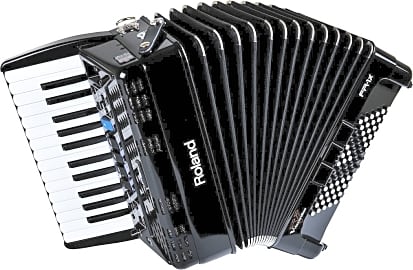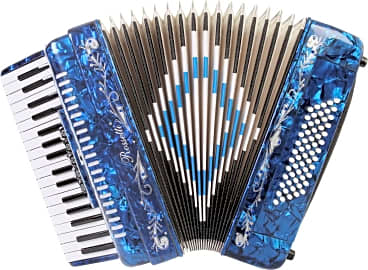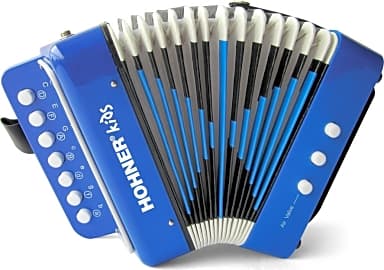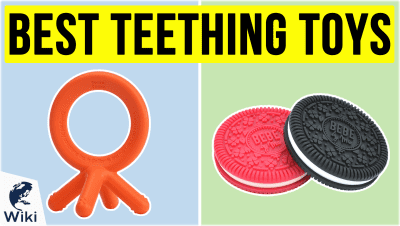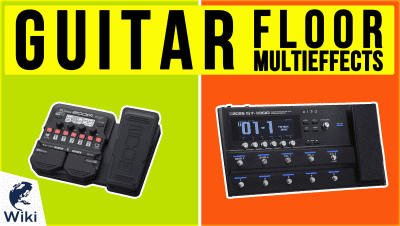The 10 Best Accordions

This wiki has been updated 35 times since it was first published in May of 2016. You don't have to be a fan of polka to enjoy the sound produced by an accordion. They are popular instruments throughout the world and can be heard in many musical styles, including the tango in Argentina, Morris dancing in Britain, zydeco in New Orleans, and countless others. We've included children's versions to introduce youngsters to the craft, as well as adult models you can get for yourself. When users buy our independently chosen editorial recommendations, we may earn commissions to help fund the Wiki.
Editor's Notes
April 03, 2020:
The clearest dividing line among the accordions in our ranking is between children's and adult models, with everything from teething toys shaped like accordions to instruments that are actually playable for kids to choose from, and a wide range of options and price points for grown-ups.
There is some consistency in stylistic approaches aimed at the music of certain cultures. Where a German-inspired accordion will have a certain tone and playability, a Russian option, like the Tulskaya Garmon Bayan Tula, will have another. The Russian instruments are probably the worst bet for beginners, as they tend to feature the highest degree of complexity, seen in this model with its nearly 200 buttons.
Newcomers to the instrument would do better to grab something with a piano keyboard like the Roland V Lite or the Rossetti Piano. This is especially true if the player in question has some experience on the piano already, as this is where the melody will take place as your other hand works chord structures in the bass buttons. That Roland model is interesting in that it's a digital offering you can play without disturbing the people around you (as long as you use headphones instead of its speakers).
Special Honors
Petosa Artista Pro Classic If you need a lot of room to compose sweeping melodies, this model offers 41 treble keys in a package that has the sound and appearance most musicians can only dream of. Its hardware is plated in genuine gold, and it's made from aged maple and with a solid tone chamber. The company guarantees it for 10 years, and at this price, they'd better. petosa.com
Bugari C4120 There are a handful of models on this site both by Bugari and by Giulietti, but this particular offering may be the cream of the crop. Its reeds are handmade for a tone that can not be reproduced anywhere else in the world, and it's available with or without chin switches. The sales team works hand-in-glove with a qualified repair service, as well. emilioaccordions.com
An Intimidating Presence
If you take your time and start with simple pieces, you’ll find that the accordion is a very forgiving and gentle instrument to discover.
The accordion is a complicated instrument. It has a slew of fragile internal parts, an incredible amount of keys and buttons for creative expression, and a size and weight that can be rather unkind to diminutive players. With a little learning, patience, and practice, however, the instrument’s mysteries begin to unravel to reveal a device that is capable of providing both melody and chord structure with relative ease.
It’s important to know the parts of an accordion and how each functions. The middle of every accordion is its bellows. This is the part of the instrument that pulls air in and pushes air out through the device’s reeds. One or both sides of the accordion may contain voicing switches that can be set to combine different octave ranges of reeds, creating deeper combinations of resonant tones. Like octaves can even be tuned slightly offset from one another to create a natural vibrato effect.
On the right side of the instrument is either a keyboard or a row of buttons designed to play specific notes, and on the left side is always a row of buttons designed to play individual bass notes and sometimes full chords. So, why do some accordions have buttons on the right and others have keys like you’d see on a piano?
Well, accordions fall into one of two important categories: unisonoric and bisonoric. Inside every accordion is a set of reeds that is controlled by the depression of buttons or keys on either side of the accordion. When you open an accordion’s bellows, air is drawn through the reeds in one direction, and it pushes out through the reeds in another when you close the bellows. Unisonoric accordions will produce the same set of tones when opening or closing the bellows, where bisonoric accordions will produce one set of tones as the bellows open, and another as they close. As such, unisonoric models often have full keyboards or a larger set of buttons on the right hand side, laid out chromatically, so that the instrument can operate in any key when moving in any direction. Bisonoric accordions have fewer buttons, as each can pull double duty for the notes you need.
While all this makes the instrument seem rather impossible to play, it’s important to remember that the majority of song structures out there utilize a pretty low number of chords from start to finish, so you might be able to find the bass buttons you need for a given song and keep them securely under the fingers on your left hand throughout. After that, gaining the ability to play a good melody can be as simple as learning a lick on a keyboard or memorizing a succession of button pushes. If you take your time and start with simple pieces, you’ll find that the accordion is a very forgiving and gentle instrument to discover.
How To Choose The Right Accordion For You
There are a lot of possibilities on the market when it comes to choosing an accordion. Part of the choice will rely on the current age and proficiency of the player, and another may lie in their desire to play a certain style of music, as some accordion types have a traditional relationship with specific genres from around the world.
More serious players will have little use for a children’s accordion, however.
If you’re getting an accordion for a very young child, or you want to have something that’s decidedly simple to play, even if that simplicity comes at the cost of sound quality or expressive possibility, then there are a few reliable children’s options on the market that could fit the bill. These usually play in only major keys, and they rarely have very many buttons on either side. Fortunately, they’re often bisonoric, so with a little practice you can use them in a variety of situations.
More serious players will have little use for a children’s accordion, however. Many newcomers to the accordion find that a unisonoric model with a full keyboard is the easiest to learn on, especially if they have an education on or an understanding of the piano. This style of accordion is a favorite among players of traditional Italian, Balkan, and some German folk music.
A larger, chromatic, button-based accordion with four or five rows of buttons on its right side is liable to be a greater challenge for many players, as the button map on the right will take a while to learn. Fans of French musette music or the Russian bayan style would do well to invest here, however, as the tonal quality and expressiveness of such an instrument is a perfect match.
Due to the limitations they put on the notes you can play in either direction of their bellows, bisonoric accordions are also a bit of a challenge compared to their keyboard-based unisonoric counterparts, though this can be an advantage in certain musical styles. Such accordions are found in styles throughout the world, though they’re most often seen in Cajun and Noreño music.
A Few Role Models
If you want to truly become a master accordionist, you need to know who your predecessors are so you can study their best work. There aren’t a lot of famous players in the US, but the world stage offers a litany of talented names.
Before he made a name for himself creating spoofs on pop songs, he was a trained and naturally talented accordionist.
One person popular in the US whose skill is virtuosic, even if the content he creates is a little silly is “Weird” Al Yankovic. Before he made a name for himself creating spoofs on pop songs, he was a trained and naturally talented accordionist. If you can find any live recordings from his concerts, you’re sure to hear him shredding extensively on the instrument.
Ukranian-born Aleksandr Hrustevich is one of the more highly regarded players on the world stage today, and you can find recordings of him with full orchestras playing a variety of classical music. Neither his style nor his presentation would be particularly attractive to much of today’s youth, however, but there are a few other options for young players looking for someone cool.
For a very cool, very unique musical experience, you could investigate a band from New York City called Golem, who expertly weave together traditional Klezmer music with punk rock. If you can catch them live, be ready for a raucous time.




